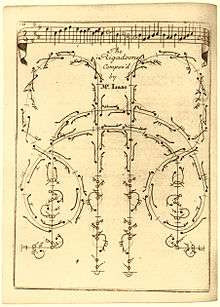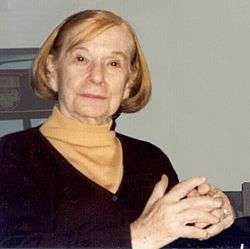Mary Ann O'Brian Malkin
Mary Ann O'Brian Malkin, editor and collector of books on dance notation.
| Mary Ann O'Brian Malkin | |
|---|---|
|
Mary Ann O'Brian Malkin | |
| Born |
March 13, 1913 Altoona, PA |
| Died |
August 1, 2005 (aged 92) New York City |
| Nationality | United States |
| Education | Pennsylvania State University |
| Occupation | Editor |
| Known for | Book collecting; philanthropy |
Mary Ann O'Brian Malkin (1913–2005) collected books on dance notation, the shorthand used by choreographers to make detailed records of their work. Especially strong in 18th-century European material, her collection, given to Penn State in 2003, was the best in private hands.[1]
Career
She was born 13 March 1913 (or, as she liked to say, on 3/13/13) in Altoona, Pennsylvania. She was the daughter of Agnes (Lynch) and Lawrence O'Brian, who worked for the Pennsylvania Railroad. A 1937 graduate of the Pennsylvania State University, she married Donald Woodward Lee, an instructor at Penn State, and the couple moved to New York City so that Lee could pursue a doctorate at Columbia University; this marriage ended in divorce. While working at the R. R. Bowker Company in the mid-1940s, she met Sol. M. Malkin, editor of the Antiquarian Bookman (AB). Malkin purchased this weekly magazine from Bowker in 1953, by which time it had become a prime source for timely news, book reviews, and coverage of trade and library conventions. It attracted a large subscription list of dealers, both those especially concerned with selling used books and those primarily engaged in the sale of new books but who ran an out-of-print search service for their customers. She worked for the magazine, which later renamed itself AB Bookman’s Weekly, as administrative assistant, copy editor and – as “Grandma Lynch” – a features writer, posing as a book collector who lived in the mountains of Frugality, PA, and who kept her books in caves (good humidity) with bear traps in front of each cave (inexpensive security). Mary Ann O'Brian married Sol. Malkin in 1953. She was a frequent book reviewer in AB especially of needlepoint and cook books (AB’s readers got quite accustomed to these reviews, madly irrelevant though they were to the concerns of most of the magazine’s subscribers). She signed her reviews with her initials, MAM – and it was as MAM that she was known to her many friends in the book and dance worlds. Sol. Malkin sold the magazine in 1972; a year later, the Malkins were jointly awarded the Clarence Day Award of the American Library Association, an award annually made to a librarian or other individual for outstanding work in encouraging the love of books and reading. The Malkins were the first non-librarians to receive this honor.
Philanthropy
In 1985, MAM established an annual lecture under the auspices of the Book Arts Press at Columbia University in honor of her husband Sol., who died in March 1986, a few months after Michael Winship gave the first lecture.[2] The Malkin lecture, later renamed the Sol. M. and Mary Ann O'Brian Malkin Lecture in Bibliography, moved with the Book Arts Press and Rare Book School (RBS) to the University of Virginia in 1992. MAM was a frequent attendee of RBS courses during the school's Columbia days, and a regular visitor to the school after its move to Charlottesville, Virginia.
From 1999 through 2004, MAM funded the New Scholars Program of the Bibliographical Society of America (BSA); each year the BSA invited three early-career scholars to present 20-minute papers at a panel preceding the annual meeting in New York City in late January. The program gave participants an opportunity to present unpublished research and to acquaint members of the Society with new work on bibliographical topics. After MAM's death, the BSA raised endowment funds to institutionalize her annual subsidy; one of the New Scholars grants is named in her honor.[3]
Though never a professional dancer herself, MAM always had an interest in both contemporary ballroom dancing and the history of dance, and she was a supporter of many dance groups and societies, including the American Dance Guild (ADG).[4] In 2003, the ADG and Columbia University co-sponsored a Mary Ann Malkin Gala Concert of dance at the Peter Norton Symphony Space in New York City in honor of her generous support of dancing and dance history.
Collecting Dance Books

MAM began to collect dance books in the mid-1970s: "Neither Sol. nor I collected books seriously during our AB days," she wrote in recollections published in the newsletter of the Fellowship of American Bibliophilic Societies.[5] "Sol. felt deeply that it would have been unfair to our subscribers for us to do so." In the 1970s, MAM acquired an 18th-century book on the history of dance that used a visual shorthand system of dance step notation. "I had trouble reading this book: stenochoregraphic dance notation has an alarming resemblance to chicken tracks," she said, but she decided to collect books showing the history of dance notation as three-dimensional objects that could be loved for themselves, as well as for their contents.[6]
She soon had a substantial collection of dance notation books, thanks in large part to the English dealer Richard Macnutt, who represented her at the 1979 Jack Cole Sotheby's sale in London.[7] Other dealers who helped her form her collection include Bennett Gilbert, Gordon Hollis of Golden Legend, the Lubranos, Bruce McKittrick, the Sallochs, and Stephen Weissman. Some of MAM's dance books were exhibited at the Grolier Club in New York City in 1986 and at the Houghton Library at Harvard in 1987. She was the principal lender to Madison U. Sowell's 1993 exhibition at Brigham Young University, The Art of Terpsichore: From Renaissance Festivals to Romantic Ballets, mounted in conjunction with a meeting of the Society of Dance History Scholars.[8] In her heyday as a collector, it was a treat to see her at an antiquarian book fair. She loved to go into a strange dealer's booth, spot an old book dealing with the history of dance, and ask to see it. The dealer would obligingly take the book out of the case and show it to her, with no thought of selling such an expensive book to a little old lady with bright orange hair. MAM would then whip out her checkbook and write a four- and sometimes even a five-figure check on the spot, handing it to the astonished but gratified dealer.
In 2002, she mounted a solo show of her books at the Grolier Club, and then gave her collection to her alma mater, Penn State, which mounted an exhibition of the books in October 2003. In 2003, she privately published the substantial Dancing by the Book, a catalog of her collection of dance notation books.[9][10] In the Introduction to this book, MAM wrote: "We could have (and should have) done more -- and worked longer and harder -- before publishing this catalogue. But I am now 90 years old, and it seems an appropriate time to show the results of our work thus far." The book, distributed by Golden Legend and by the Lubranos, was designed by Jerry Kelly, with photographs by Ropbert Lorenzson.
Toward the end of her life, MAM's eyesight began to fail, and she became unsure on her feet. She fell twice in 2004, breaking first one hip and then the other. Mentally she remained alert, however, and with help from home care worker Ceceal Sergeant, she graduated to a three-wheeled walker and then to a cane. In July 2005, MAM took a train to Charlottesville to attend the 21st annual Sol. M. and Mary Ann O'Brian Malkin Lecture in Bibliography, given on July 27 by Richard Wendorf, then the Director of the Boston Athenaeum, and to attend a dinner in her honor. She seemed tired but well when she returned to New York City on Friday, 30 July, and in a telephone conversation on Sunday night she gave a lively account of her visit to RBS to a friend; but she died, apparently in her sleep, later that evening.[11] She was 92 years old. There were no near surviving relatives. MAM's temperament was a sunny one. She was remarkably without self-pity of any kind, and she was always good company. In later life, she was glad that she had the means to support generously two of her principal interests: dance and the history of the book. Her residual estate was divided between the Grolier Club and Rare Book School.
References
- ↑ <http://www.nytimes.com/2005/08/14/arts/14malkin.html> Obituary; accessed 1 December 2010.
- ↑ For a photograph of Belanger, MAM, and Winship, see the front cover of AB Bookman's Weekly, 20 January 1986.
- ↑ <"Archived copy". Archived from the original on 2010-12-06. Retrieved 2010-12-01.>
- ↑ <http://www.polishculture-nyc.org/printIndex.cfm?itemId=111&eventId=1050>
- ↑ Mary Ann O'Brian Malkin, "Article name to come," in the Fellowship of American Bibliophilic Societies Newsletter 8/2 (Fall 2004), pp. 15-17.
- ↑ See <http://www.baroquedance.com/research/dancenotation.htm> (accessed 1 December 2010) for a description of the dance books MAM liked to collect.
- ↑ For the choreographer Jack Cole, see <http://www.filmreference.com/Writers-and-Production-Artists-Ch-De/Cole-Jack.html>Accessed 1 December 2010.
- ↑ <http://www.deseretnews.com/article/337331/DANCE-RELATED-RARE-BOOKS-PRINTS-ON-DISPLAY-AT-BYU.html> Accessed 1 December 2010.
- ↑ Mary Ann O'Brian Malkin, assisted by Moira Goff & Jennifer Thorp and by Terry Belanger & Richard Noble. Dancing by the Book: A Catalogue of Books 1531-1804 in the Collection of Mary Ann O'Brian Malkin. New York: Privately Printed, 2003.
- ↑ <http://psuspcol.us.splinder.com/post/485271/copies-of-dancing-by-the-book>
- ↑ <http://hq.abaa.org/antiquarian/images/pdfs/fall2005.pdf>Accessed 1 December 2010. Terry Belanger, "Mary Ann Malkin," in The ABAA Newsletter, 16:4 (Fall 2005), p. 14.
